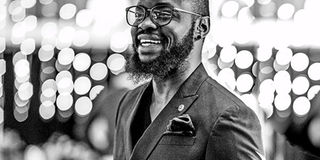TAKE 6: Sebastian Wanzalla

Sebastian Wanzalla is a photographer. He describes himself as a flexible and passionate creative who is not afraid of going against the grain. PHOTO| COURTESY
What you need to know:
- School will never go out of fashion. I learnt art and design while I was still in high school.
- The same principles of design apply in photography, and I believe that’s why the switch was fluid and effortless for me.
- So yes, school is important, and should never be avoided.
Sebastian Wanzalla is a photographer. He describes himself as a flexible and passionate creative who is not afraid of going against the grain.
1. How did you end up being a photographer? What was your first camera type?
I am a graphic designer and was really into motion graphics and 3D animation, but God had other plans for me.
One day I picked up a camera and the few shots I took changed my destiny.
Everyone around me loved the pictures, and after that I vowed to do something to get better at taking pictures. My first camera was a Nikon D100. It was very slow, but I loved it.
2.Is it important for a photographer to go to school, or is talent the only key requirement?
School will never go out of fashion. I learnt art and design while I was still in high school.
The same principles of design apply in photography, and I believe that’s why the switch was fluid and effortless for me. So yes, school is important, and should never be avoided.
I believe going to school helps you enhance your talent and maximise on it.
3.From where do you draw your inspiration? Is there a difference between passionate photographers and those who do it just to earn money?
Yes, there is a huge difference. Anyone who is good at photography was first passionate about it, and then it paid off.
My inspiration comes from the world I live in. I get bored quickly, which explains why I travel so often.
4.Who do you look up to in terms of photography, locally and internationally?
Locally, I admire Osborne Macharia. He has developed and maintained his style and earned international recognition. In Africa, my idol is Kelechi Amadi-Obi from Nigeria. His work is near perfect.
His pictures look so vivid, and that is something you rarely get. Another photographer I admire is Ghanaian Emmanuel Bobby aka Bobpixel. His photography is breathtaking.
Internationally, there are many names but Joey L has inspired me for years. I’ve learnt a lot from him. He will always be a legend.
5. Why aren’t there as many female photographers as there are male ones? What do you think should be done to change this?
Photography has been a male-dominated field for a long time, but things are gradually changing. I believe the situation is the same worldwide.
Women are smart and always more careful than men. Photography in particular, and content generation in general, is quite demanding. The pressure to always be on top can make anyone, not just women, cautious. However, this can and should change.
Women can aggressively establish themselves in niche markets such as baby bump shoots, fashion and wedding photography.
These are emerging fields that are not traditionally masculine. They are open to anyone with an eye for business.
The number of female photographers seem to be rising, which is very encouraging.
6.What do you do to nurture budding photographers?
I have never wanted to be a leader, or someone who will save the world. There is Boniface Mwangi for that (chuckles).
My life has literally been about survival, and trying to live a meaningful life. I get a lot of e-mails and phone calls from upcoming photographers, and although I have declined to attend so many mentorship workshops, this year I accepted one such invite.
The feedback was overwhelming. I realised that I could change someone’s life just by sharing my experiences.





